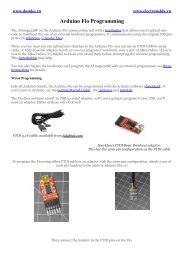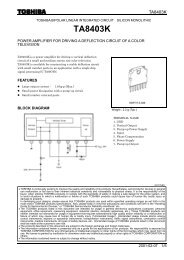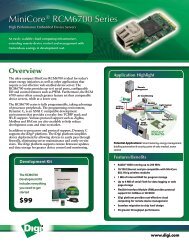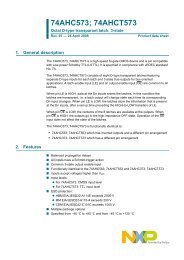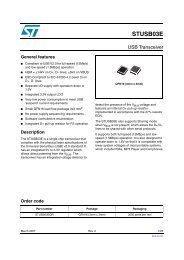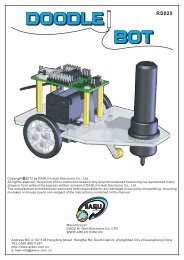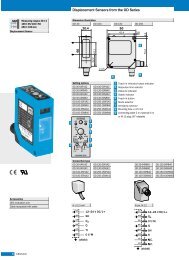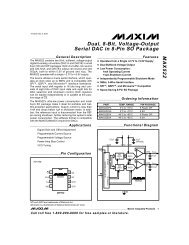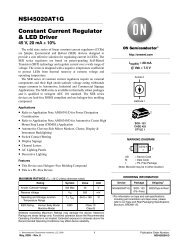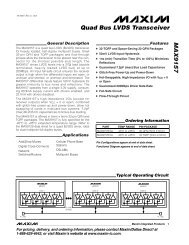12-Bit Quad Voltage Output Digital-to-Analog Converter
12-Bit Quad Voltage Output Digital-to-Analog Converter
12-Bit Quad Voltage Output Digital-to-Analog Converter
Create successful ePaper yourself
Turn your PDF publications into a flip-book with our unique Google optimized e-Paper software.
ANALOG OUTPUTS<br />
When V SS = –5V (dual supply operation), the output amplifier<br />
can swing <strong>to</strong> within 2.25V of the supply rails, guaranteed<br />
over the –40°C <strong>to</strong> +85°C temperature range. With V SS<br />
= 0V (single-supply operation), the output can swing <strong>to</strong><br />
ground. Note that the settling time of the output op-amp will<br />
be longer with voltages very near ground. Also, care must be<br />
taken when measuring the zero-scale error when V SS = 0V.<br />
Since the output voltage cannot swing below ground, the<br />
output voltage may not change for the first few digital input<br />
codes (000 H , 001 H , 002 H , etc.) if the output amplifier has a<br />
negative offset.<br />
The behavior of the output amplifier can be critical in some<br />
applications. Under short circuit conditions (DAC output<br />
shorted <strong>to</strong> ground), the output amplifier can sink a great deal<br />
more current than it can source. See the specification table<br />
for more details concerning short circuit current.<br />
REFERENCE INPUTS<br />
The reference inputs, V REFL and V REFH , can be any voltage<br />
between V SS +2.25V and V DD –2.25V provided that V REFH is<br />
at least 1.25V greater than V REFL . The minimum output of<br />
each DAC is equal <strong>to</strong> V REFL plus a small offset voltage<br />
(essentially, the offset of the output op-amp). The maximum<br />
output is equal <strong>to</strong> V REFH plus a similar offset voltage. Note<br />
that V SS (the negative power supply) must either be<br />
connected <strong>to</strong> ground or must be in the range of –4.75V <strong>to</strong><br />
–5.25V. The voltage on V SS sets several bias points within<br />
the converter, if V SS is not in one of these two configurations,<br />
the bias values may be in error and proper operation<br />
of the device is not guaranteed.<br />
The current in<strong>to</strong> the V REFH input depends on the DAC output<br />
voltages and can vary from a few microamps <strong>to</strong> approximately<br />
0.5 milliamp. The V REFH source will not be required<br />
<strong>to</strong> sink current, only source it. Bypassing the reference<br />
voltage or voltages with at least a 0.1uF capaci<strong>to</strong>r placed as<br />
close <strong>to</strong> the DAC7624/25 package is strongly recommended.<br />
DIGITAL INTERFACE<br />
Table I shows the basic control logic for the DAC7624/25.<br />
Note that each internal register is level triggered and not<br />
edge triggered. When the appropriate signal is LOW, the<br />
register becomes transparent. When this signal is returned<br />
HIGH, the digital word currently in the register is latched.<br />
The first set of registers (the Input Registers) are triggered<br />
via the A0, A1, R/W, and CS inputs. Only one of these<br />
registers is transparent at any given time. The second set of<br />
registers (the DAC Registers) are all transparent when LDAC<br />
input is pulled LOW.<br />
Each DAC can be updated independently by writing <strong>to</strong> the<br />
appropriate Input Register and then updating the DAC<br />
Register. Alternatively, the entire DAC Register set can be<br />
configured as always transparent by keeping LDAC LOW—<br />
the DAC update will occur when the Input Register is<br />
written.<br />
The double buffered architecture is mainly designed so that<br />
each DAC Input Register can be written at any time and then<br />
all DAC voltages updated simultaneously by pulling LDAC<br />
LOW. It also allows a DAC Input Register <strong>to</strong> be written <strong>to</strong><br />
at any point and the DAC voltage <strong>to</strong> be synchronously<br />
changed via a trigger signal connected <strong>to</strong> LDAC.<br />
STATE OF<br />
SELECTED SELECTED STATE OF<br />
INPUT INPUT ALL DAC<br />
A1 A0 R/W CS RESET LDAC REGISTER REGISTER REGISTERS<br />
L (1) L L L H (2) L A Transparent Transparent<br />
L H L L H L B Transparent Transparent<br />
H L L L H L C Transparent Transparent<br />
H H L L H L D Transparent Transparent<br />
L L L L H H A Transparent Latched<br />
L H L L H H B Transparent Latched<br />
H L L L H H C Transparent Latched<br />
H H L L H H D Transparent Latched<br />
L L H L H H A Readback Latched<br />
L H H L H H B Readback Latched<br />
H L H L H H C Readback Latched<br />
H H H L H H D Readback Latched<br />
X (3) X X H H L NONE (All Latched) Transparent<br />
X X X H H H NONE (All Latched) Latched<br />
X X X X L X ALL Reset (4) Reset (4)<br />
NOTES: (1) L = Logic LOW. (2) H= Logic HIGH. (3) X = Don’t Care. (4) DAC7624 resets <strong>to</strong> 800 H , DAC7625 resets <strong>to</strong> 000 H . When RESET rises, all registers that<br />
are in their latched state retain the reset value.<br />
TABLE I. DAC7624 and DAC7625 Control Logic Truth Table.<br />
®<br />
DAC7624/7625<br />
10



